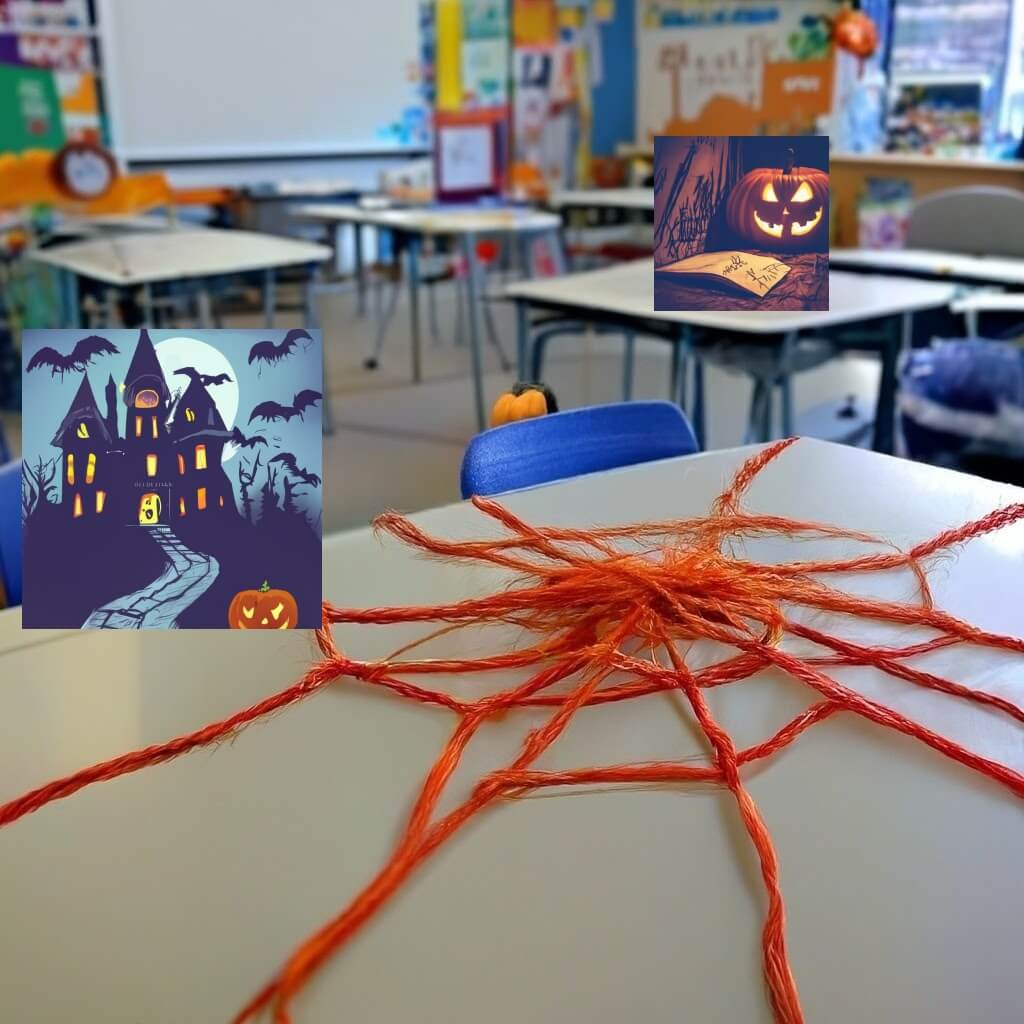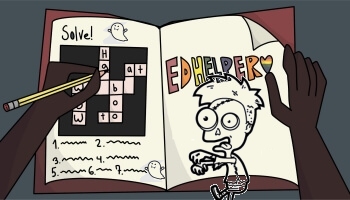Halloween Activities for the Classroom That Are Educational and Fun
By: edHelper Staff
Updated: Oct 9, 2023

Halloween is an exciting time for students. As the holiday approaches, costumes, decorations, desserts, and trick-or-treating can make concentrating at school difficult.
Don't fight all that Halloween excitement when you can incorporate it into your classroom!
Here are our favorite Halloween-themed activities for the classroom that aren't just fun-they're educational, too.
Frankenstein Magazine Scrap Activity
Students are sure to have a blast creating their very own Frankenstein monster with cuttings from magazines. It's a fun activity and a great way to learn body parts.
Collect magazines, posters, and other printed materials from parents, other teachers, and friends to pass out to your students with scissors. Give them a list of body parts to collect and let them cut out different parts from those magazines. They can glue all those parts to a piece of paper and label them to create their own Frankenstein monster.
You can adjust the activity to your students' levels of knowledge. For example, young elementary students might label things like legs, feet, pelvis, and shoulders, while older elementary students could cut out the body parts that correspond to the bones underneath, like the femur, clavicle, and skull.
You can extend this activity by asking students to write a short story about the Frankenstein monster they created. Hang them on the wall, and they make great Halloween décor!
Halloween Writing Web
Looking for an activity that gets your students excited about writing during the Halloween season? Try a Halloween-themed writing web!
Start by creating an actual web that's made of yarn. Then, place 4x6 notecards all over the web.
If you teach young elementary students, each card might contain a single word. Try to keep words themed for Halloween, like "spooky," "pumpkin," "candy," and "costumes." Then, students can see how many words they can use in their own Halloween story.
List story ideas if you're working with older elementary or middle school students. A few ideas include:
- Write a menu for a restaurant called "The Devil's Kitchen."
- Write a recipe for a witches' brew and describe what it's for.
- Create a plot for a TV episode of a show called "Scare-o-rama."
- Write a story about something that happened in a town called "Ghoulsville."
- Design a monster house, and then write copy as a real estate agent trying to sell the house.
- Write a job description for a position titled "Head Brain-Eating Zombie."
Let each student choose the one that they want to write about. When everyone is done, let them share what they wrote with the class.
Halloween Mini Activity Workbooks
Describe a Pumpkin and Other Halloween Items
Bring in a pumpkin or a carved jack-o'-lantern and have kids describe it using adjectives. Then, use a marker to write all of their responses directly on the pumpkin. At the end of the activity, ask the students to write a sentence that describes the pumpkin using some of the adjectives the class brainstormed.
You can use more than just a pumpkin! This is an especially great idea for classes that are actively working on adjectives during the Halloween season. You can bring in other Halloween-themed décor items for kids to describe, including one of these:
- A skeleton
- A spider
- A witch's hat
- A ghost
If you're working on adjectives with an older bunch of students, try bringing in objects that are a bit harder to describe. Have them list adjectives for the cottony spiderwebs you can buy at the store or describe the fog from a fog machine.
Pin the Legs on the Spider
Pin the Legs on the Spider is a fun game on its own when you play it like a game of Pin the Tail on the Donkey, but it has the potential to be so much more.
Try playing the game with a purpose instead. For example, you might write one math equation on each spider leg and then hand one to each student. Give your students time to work out their math equations. Then, call out a number. The student with the equation that matches that number puts their leg on the spider. This game gives your students the chance to practice addition, subtraction, multiplication, division, or even fractions, depending on what you're currently working on in math.
You could also do an order activity and have two students race as they try to put all eight legs on their spiders in order first. Just put two spider bodies up on the wall and give each student a set of eight legs. Students can pin up their legs in order by finding the answers to math problems or important dates in social studies.
Teach a Little Halloween History
A lot of events in history correspond with Halloween, and many of them are very interesting to kids. Why not take a little time to teach that history?
For example, most students are usually fascinated with the Salem witch trials. If you have older students, consider having them read The Witch of Blackbird Pond by Elizabeth George Speare as a small group activity during reading time. If you've got a younger bunch, try reading aloud You Wouldn't Want to Be a Salem Witch by Jim Pipe.
Students are sure to be fascinated by a mini social studies unit on the history of Halloween. There are a lot of opportunities to compare and contrast how people used to celebrate Halloween compared to how it is celebrated today.
The history of some of our favorite ghouls can be fun to tackle, too. Your students may be surprised to learn that a woman wrote Frankenstein or that mummies can be found in more places than just Egypt.
Just make sure that whatever you choose to teach is age- and school-appropriate, as some topics might be off-limits. For example, you may not want to talk about zombies with first graders, and the religious implications of the holiday should be avoided.
Compare Favorite Halloween Characters With a Venn Diagram
You can have your students compare and contrast their favorite Halloween characters with a Venn diagram. Let older students choose their favorite characters. They can get as scary (or not) as they want, but don't hesitate to give them ideas if they're feeling a bit stuck.
Encourage them to think by comparing "real" ghosts to stereotypical Halloween ghosts. If they're really into it, let them compare more than one. For example, they could create a triple Venn diagram comparing famous Hollywood ghosts, like Slimer from Ghostbusters, Moaning Myrtle from Harry Potter and the Chamber of Secrets, and Casper the Friendly Ghost.
Younger kids can keep things simple. Ask the class to help you come up with a list of Halloween things they can compare. Then, let them choose. They might compare a pumpkin and a skeleton or a black cat and a witch.
The fun things you can do with your students to celebrate Halloween are endless, but it can be a bit more difficult to find things that are both fun and educational. That's not the case with these ideas! With the tips on this list, you can keep your students engaged throughout the spooky season.
Halloween-Themed Worksheets and Workbooks
It's easy to put a spooky twist on nearly every subject with the right Halloween-themed worksheets and workbooks!
You can find fun worksheet pages for math with Halloween themes, as well as short story starters and reading comprehension activities for every grade level. Students can complete them during class, or they can be taken home as homework.
There are a lot of great, fun filler activities, too! Students can complete color-by-number pages, word finds, crosswords, and more that help them practice skills. They are great to have available for students who get to school early or early finishers who need something to do before the next subject starts.













